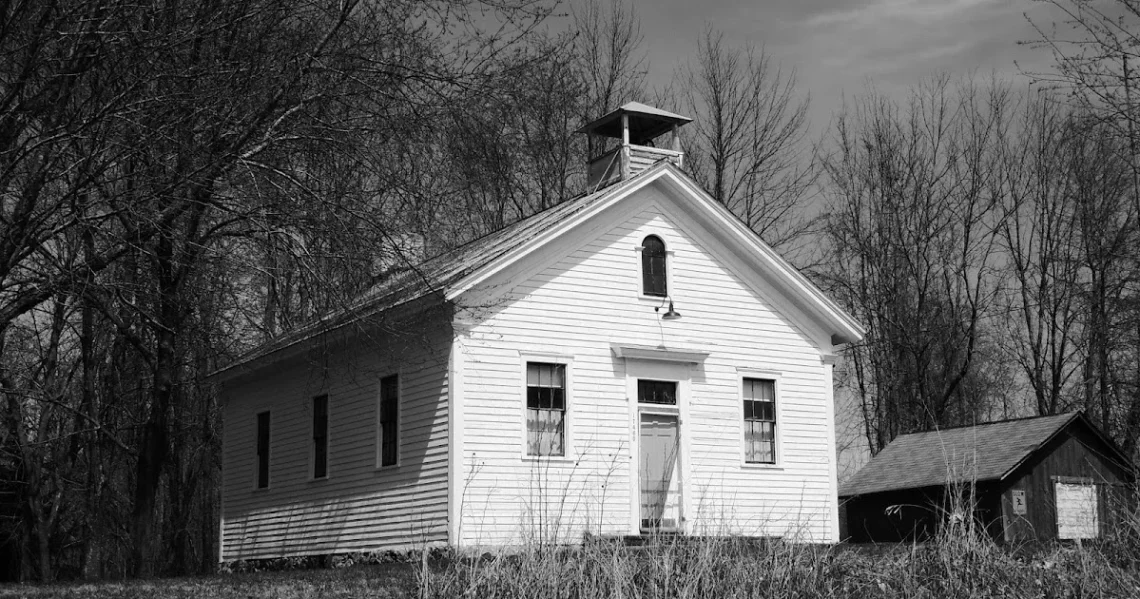Background: The Historic Schoolhouse and Its Stone Monument
Muskegon County Schoolhouse Historic Stone Theft: In Fruitland Township, Muskegon County, Michigan, a 123-year-old schoolhouse stands as a local landmark. Recently, a stone slab from that schoolhouse was reported missing, sparking efforts by the property owner and the community to recover the piece of regional heritage.
The missing stone was not just a random architectural fragment—it had been designated for donation to the township hall as part of a preservation plan.The owner of the site where the original one-room school once stood is now publicly asking for the stone’s return
Because so few artifacts from the original structure remain, this stone carried symbolic and historical significance. Its theft represents not just a property crime, but a blow to community memory, heritage conservation, and local identity.
Details of the Theft: What Is Known So Far
While investigations are ongoing, several significant details have emerged:
-
The stone slab was removed sometime before the planned donation.
-
The property owner discovered the absence of the stone and has since made a public appeal for its return.
-
Video news coverage has circulated showing the owner speaking to media about this missing piece.
-
The stone was to be transferred to the township hall—indicating that before its disappearance, it was already being treated as a heritage artifact rather than mere construction material.
However, what is still unclear:
-
Exactly when the theft took place (date/time).
-
Who removed the stone—whether an individual, a group, or under some mistaken permission.
-
Whether the stone has been relocated nearby, sold, or discarded.
-
The stone’s physical condition, its signage, or any unique markers that might make it identifiable.
The public appeal suggests hope that someone with conscience or awareness might return it without legal escalation.
Why This Stone Matters: Historical & Cultural Significance
To grasp why its theft matters, we must look at the role of historic structures and artifacts in local heritage.
Heritage & Connection to Past
The one-room schoolhouse is itself a remnant of an earlier era—when rural education was administered in small, local buildings. Its masonry stonework, original design, and original fabric (including foundational slabs) are rare survivors of that epoch. The missing stone was part of the tangible architectural legacy.
Symbolic Value
Because the stone had been earmarked for donation to the township hall, it was meant to continue public visibility, preserving the link between past and present. Having that piece visible in civic space connects citizens to their roots.
Educational & Touristic Potential
Historic schoolhouses often function as local museums, sites of walking tours, or educational stops. Retaining authentic materials (original stones, timbers, plaques) improves authenticity and helps storytelling. Losing a key stone fragments that narrative.
Precedents & Preservation Risk
In many places, historic buildings lose original material over time—due to decay, remodeling, or theft. Each loss reduces the structure’s historic integrity. This theft is a warning: historic elements are vulnerable, even in small, local sites.
Thus, the stolen stone is not just masonry; it is a vestige of local history and a reminder that preservation must be active, not passive.
Response & Recovery Efforts
Once the disappearance was noticed, multiple steps have been taken (or proposed) to recover the stone and mitigate damage.
Public Appeal & Media Coverage
The property owner has gone public through local news outlets, asking for whoever took the stone to return it. A video news piece covers the owner’s plea. This coverage helps raise awareness and increases odds someone may come forward.
Community and Township Engagement
Given the stone was intended for donation to the township hall, local officials may be involved or at least supportive. The community’s interest in preserving their heritage can rally volunteer search efforts, social media posts, or tips to local law enforcement.
Legal & Law Enforcement Involvement
While the public appeal is civil in tone, theft of historic property may escalate to involving law enforcement. If the stone has identifiable markers or historical registration, authorities could classify its removal as a crime against an historic property.
Documentation & Identification Aids
To help its recovery, photos, descriptions, and any distinctive features (inscribed dates, carving features, wear marks) are crucial. If those details are distributed to stone dealers, salvage yards, or local networks, they may help spot the slab if it is moved.
Preservation Planning
Even as efforts to recover the stone continue, the incident will likely prompt the owner and community to review security measures for other artifacts, improved signage, locked display or protective storage, or monitored donation logistics.
The theft underscores that preserving built heritage also involves protection strategy.
Implications & Lessons for Historic Preservation
This stone theft case has broader lessons for communities, preservationists, and public policy.
Vigilance Over Assumed Safety
Historic elements—even small ones—are not automatically safe. Smaller sites, rural locations, or less-publicized landmarks might be especially vulnerable. This calls for active oversight, not assuming that “no one will steal that.”
Community Awareness & Ownership
When locals understand the value of their heritage, they become watchers and protectors. Public education campaigns, signage, heritage walks—these cultivate a sense of ownership that discourages theft.
Documentation & Archival Redundancy
Every piece of historic material should be documented in photographs, drawings, catalog entries. That way, when a piece is lost, its memory and identifying details remain and assist recovery.
Partnerships & Municipal Support
Local government, historical societies, and preservation agencies should partner. Donations, site transfers, restoration projects, and historic care need municipal awareness, funding, and policy support.
Rapid Response Systems
When a theft is discovered, prompt public appeals, press coverage, and coordination with law enforcement increase chances of recovery before materials are cut, destroyed, or dispersed.
Balance Access and Protection
Historic artifacts often have value because people see them. But access must be balanced with security. Displaying items in protected contexts (behind locks, in secure display zones) helps preserve them while allowing public engagement.
Conclusion: Recovering a Piece of Muskegon History
The mysterious theft of the historic stone from a Muskegon County one-room schoolhouse is more than an act of property removal—it’s a symbolic assault on community memory and heritage. That the stone was to be donated for public display emphasizes its intended role as a bridge between past and present. The owner’s public plea, media coverage, and community interest offer hope that the slab may still return.
As investigations proceed, this case represents a cautionary tale for guardians of historical sites: document everything, secure artifacts, engage the public, and be ready to act quickly when loss happens. Each stone, beam, or artifact is irreplaceable in telling the full story of local history. Recovery of this piece—or at least preserving its recorded memory—will help the community retain that connection.





